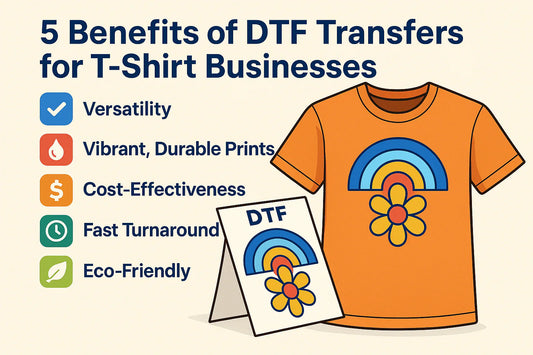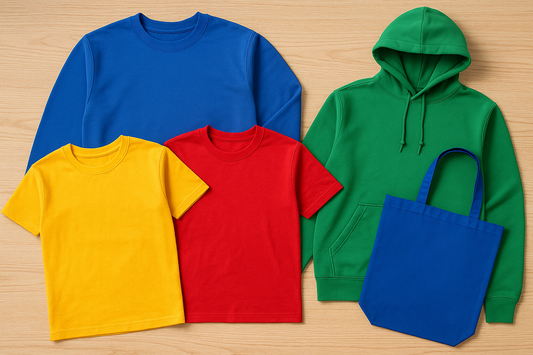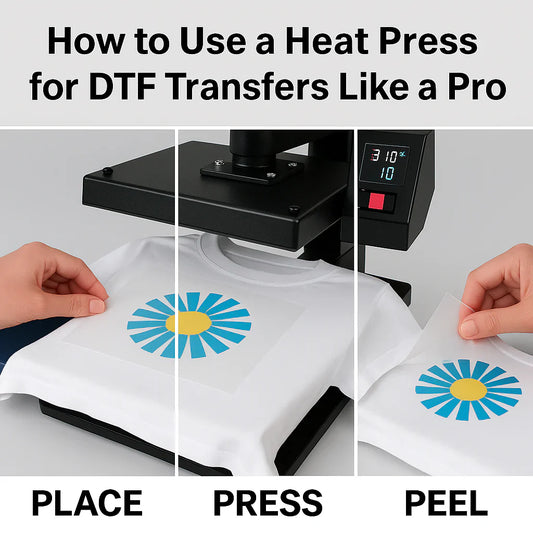Understanding DTF and HTV Printing Techniques
In the world of garment printing, two techniques stand out: DTF and HTV. Both have their unique strengths and applications.
DTF, or Direct to Film, is a newer technology. It's known for its ability to print vibrant, detailed designs on a variety of fabrics.
On the other hand, HTV, or Heat Transfer Vinyl, is a tried-and-true method. It's loved for its durability and the ability to layer designs.
But how do you choose between DTF and HTV? Which one is better for your specific needs?
This guide aims to answer these questions. We'll delve into the intricacies of both DTF and HTV printing techniques.
We'll compare their material flexibility, durability, and the quality of prints. We'll also discuss the feel of the final product, a common concern for many.
By the end of this guide, you'll have a clear understanding of both DTF and HTV. You'll be equipped to make an informed decision for your printing needs.
Let's dive in and explore the fascinating world of DTF and HTV printing techniques.
What is DTF Printing?
DTF, or Direct to Film, is a cutting-edge printing technique. It allows vibrant designs to be transferred onto various fabrics.
This method involves printing designs onto a special film. After this, the design is coated with a powder adhesive.
Once coated, the film is heated to cure the adhesive. This step prepares it for transfer onto fabric.
The fabric receives the design through a heat press. This process ensures high durability and vivid colors in the final print.
DTF printing is celebrated for its ability to reproduce fine details. This makes it a favored choice for intricate designs and full-color images.
What is HTV?
HTV, or Heat Transfer Vinyl, is a popular printing method. It uses vinyl sheets to create designs on fabric surfaces.
This technique involves cutting designs out of vinyl sheets. A cutting machine precisely trims each design for accuracy.
Once the design is cut, it's placed onto fabric. Applying heat and pressure transfers the design to the material.
The heat press is crucial in HTV application. It ensures the adhesive on the vinyl bonds well with the fabric.
Heat Transfer Vinyl is versatile and used widely in DIY projects. It is valued for its vibrant colors and durability.
DTF vs HTV: Material Flexibility and Fabric Compatibility
Material flexibility is a crucial factor in printing. DTF, or Direct to Film, offers a soft and flexible print finish.
HTV tends to be slightly thicker. This can affect the fabric's natural stretch and feel.
Fabric compatibility is a deciding factor for many users. DTF can be used on a variety of fabrics, including cotton, polyester, and blends.
HTV also works on many materials, but with more care. Some fabrics may require special HTV types for optimal adhesion.
According to Pool, HTV has advanced to the point where decorators can confidently use it on non-traditional surfaces, such as baseball gloves, by layering materials for added durability.
https://www.deconetwork.com/how-htv-is-thriving-in-the-age-of-dtf-lets-get-printing/
Here's a comparison list of fabric compatibility:
-
DTF: Cotton, polyester, blends, leather
-
HTV: Cotton, polyester, spandex (with stretch HTV)
Choosing between DTF and HTV depends on the fabric type. Some projects might demand the flexibility of DTF, while others suit HTV well.
Durability and Quality of Prints
When it comes to durability, print longevity matters significantly. DTF prints excel in this area, offering impressive washability that withstands frequent laundering.
HTV prints provide good durability but might show signs of wear over time. The vinyl can peel or crack, especially with improper care or frequent washing.
Quality of prints also plays a big role in deciding the right technique. DTF printing produces vivid colors and excellent details, making it ideal for intricate designs.
HTV, while vibrant, may limit the complexity of designs due to its application process. The weeding process for HTV might compromise tiny details, leading to simpler patterns.
Both methods cater to different durability needs. In environments where frequent washing is unavoidable, DTF might be the superior choice. Meanwhile, HTV works well for projects requiring fewer washes and simpler designs, offering a durable and quality finish.
The Feel Factor: Does DTF Feel Like Vinyl?
A common question is whether DTF prints feel like vinyl. The texture can play a big role in user preference.
DTF prints tend to feel softer and more integrated into the fabric. This gives garments a smooth and natural hand feel.
In contrast, HTV typically sits on top of the fabric. This often results in a thicker, more pronounced finish.
Ultimately, the feel of each method can influence the choice between DTF and HTV. While some prefer the softness of DTF, others may choose the distinctive feel of HTV.
Cost and Setup: Investing in DTF or HTV
When considering DTF and HTV, understanding the cost and setup is vital. Each method requires a different investment level.
DTF printing often involves higher initial costs. Equipment like printers, software, and consumables add up quickly. This can be a barrier for small operations.
HTV is more accessible for beginners and hobbyists. It often requires fewer upfront expenses. Basic equipment includes a vinyl cutter, which is more budget-friendly.
However, operating costs differ. DTF can be more cost-efficient for large prints. HTV can become costly when producing intricate multi-color designs.
Key factors in investment include:
-
Equipment: DTF printers vs. vinyl cutters
-
Materials: DTF films and adhesives vs. vinyl rolls
-
Scalability: DTF's suitability for bulk vs. HTV's batch flexibility
Ultimately, the choice depends on production needs and budget. Weighing these factors can help make an informed decision.
Learning Curve and Ease of Use
DTF printing appeals due to its simplicity in execution. Once setup is complete, it requires minimal manual intervention. This makes it attractive for users with less technical skill.
HTV, however, is known for its hands-on process. Beginners may face challenges with the weeding step. Precision and attention are crucial in cutting and applying designs.
For novices, HTV offers a tangible introduction to garment printing. Yet, it demands patience and practice to master. Small business owners often find HTV practical for limited production.
Conversely, DTF enables faster workflow and boosts productivity. Its straightforward process may lead to quicker proficiency, especially in mass production contexts.
Production Speed and Mass Production Capabilities
DTF printing is well-regarded for its efficiency. It can produce vibrant designs quickly without much delay. This makes it ideal for businesses aiming to fulfill large orders swiftly.
Mass production becomes seamless with DTF due to less manual labor involved. This process streamlines operations and reduces the risk of errors. Business owners benefit from shorter turnaround times and increased output.
HTV, however, often requires more time, especially for intricate designs. Each step, from cutting to pressing, demands a careful approach. This can slow down production in high-volume scenarios.
For those focusing on bulk orders, DTF may offer a significant edge. It excels in handling continuous workflows and large-scale tasks without sacrificing quality.
Environmental Considerations and Waste Management
DTF printing involves digital processes, which can reduce material waste significantly. The absence of a weeding step decreases the amount of leftover material. This can lead to a cleaner work environment and less landfill contribution.
HTV typically generates more waste due to its cutting and weeding stages. The excess vinyl often ends up discarded, which is less eco-friendly. Many businesses seek recycling options to manage this waste more responsibly.
The inks used in DTF can sometimes pose environmental challenges. It's important to select non-toxic, biodegradable options when possible. This choice can help minimize the ecological impact.
Both methods offer potential for eco-friendly practices. Adopting sustainable materials and mindful waste disposal can enhance a brand's environmental credentials. Engaging in such practices aligns with growing consumer demand for sustainability.
Heat Press Requirements: DTF vs HTV
A heat press is vital for both DTF and HTV printing techniques. However, their requirements differ significantly. DTF requires precise temperature and pressure settings to achieve quality prints.
In HTV printing, heat presses are also crucial. They secure the vinyl onto fabrics by applying heat and pressure. The settings may vary depending on the type of vinyl used.
DTF printing generally needs a more consistent heat distribution. This helps in transferring the ink evenly across the film. Ensuring high-quality results depends on this consistency.
Both methods benefit from high-quality heat presses. Selecting a reliable machine can enhance print outcomes and longevity. Therefore, it's crucial to choose the right equipment for effective application.
Customization and Design Potential
Customization is crucial in garment printing. Both DTF and HTV offer impressive options. DTF excels in capturing complex designs and intricate details with vibrant colors.
HTV, on the other hand, shines in layering. You can layer vinyl for multi-dimensional designs. This method offers great creative flexibility, though it demands precision.
DTF's ability to print gradients is a standout feature. It allows for full-color spectrum designs, enhancing visual appeal. This makes it ideal for detailed artwork and photo-realistic prints.
In contrast, HTV requires careful design preparation. The need for weeding affects complex designs. Yet, both techniques offer unique opportunities for creativity and customization.
The Future of Printing: DTF and HTV Trends
DTF and HTV are continuously evolving. Innovations are driving these techniques forward. DTF's advancements in technology have expanded its capabilities.
HTV is also witnessing growth. New materials and finishes are being developed. This evolution keeps HTV relevant in the market.
DTF stands out with on-demand printing. It caters to the need for quick turnarounds. As customization becomes more popular, DTF gains traction.
Meanwhile, HTV remains favored for quick home projects. Its ease of use and versatility make it accessible for all skill levels. The future looks bright for both techniques.
Customization Opportunities with DTF and HTV
Both DTF and HTV printing offer exciting opportunities for customization. DTF shines in handling intricate, high-resolution designs, making it a go-to for photo-realistic prints and gradients. Its ability to print complex images with vibrant details opens up possibilities for unique branding and creative apparel. Meanwhile, HTV excels in layering different vinyl types to create multi-dimensional, textured designs. This method is especially appealing for projects that require bold, striking visuals with added depth. Choosing between these techniques often comes down to the level of customization and detail required for your project.
Scalability and Business Applications
For businesses looking to scale their operations, DTF printing provides a clear advantage. Its streamlined workflow and ability to handle large orders efficiently make it a practical choice for high-demand scenarios. With DTF, businesses can expand their product lines to include full-color, custom designs without the delays of manual labor. HTV, while less suited for mass production, remains a valuable option for small-scale operations and personalized orders. Its simplicity and lower setup costs make it an excellent choice for hobbyists or entrepreneurs entering the custom apparel market.
Balancing Cost with Creative Freedom
When deciding between DTF and HTV, balancing cost with creative freedom is key. While DTF involves a higher initial investment in equipment and consumables, it offers unmatched flexibility for complex designs and vibrant color ranges. This makes it an excellent option for long-term profitability in diverse product offerings. HTV, on the other hand, is more affordable for small-scale or one-off projects. It allows for experimentation with layering and textures at a lower upfront cost. By weighing the costs against your specific printing needs, you can find the technique that best supports your creative vision and budget.
Conclusion: Choosing the Right Technique for Your Needs
Choosing between DTF and HTV depends on your needs. Consider your project's scale and fabric types. Each technique offers unique benefits.
DTF excels in vibrant colors and detailed designs. It's ideal for complex images and quick production. HTV, however, is perfect for layering and custom apparel.
Evaluate your budget and equipment. DTF requires more upfront investment. HTV is simpler with lower entry costs.
Ultimately, both methods can create stunning prints. Your choice should align with your goals and capabilities. Explore, learn, and decide which fits you best.
Whether you're interested in exploring DTF printing for vibrant, detailed designs or HTV for bold, layered creations, we're here to help bring your vision to life. At Sam's DTF Transfers, we offer premium-quality custom DTF printing services tailored to meet your needs. Whether you’re looking for small-batch orders, full-color designs, or detailed personalization, we’ve got you covered. Visit our product page to explore our offerings or check out the Gang Sheet Builder for your larger, multi-design projects.
Have questions or need guidance? Our dedicated support team is ready to assist you. Reach out to us through our support page or give us a call to discuss your printing needs. Let us help you turn your designs into reality with unmatched quality and speed!
What are the advantages of choosing DTF printing over HTV?
DTF printing offers vibrant, full-color designs and excellent detail reproduction. It works on a wide range of fabrics, including cotton, polyester, and blends, without needing extensive preparation. DTF is also ideal for intricate designs, gradients, and photo-realistic prints, making it perfect for custom apparel and high-detail projects.
Can I order custom DTF transfers for my unique designs?
Yes! At Sam's DTF Transfers, we specialize in bringing your unique designs to life. Simply upload your artwork to our custom DTF transfer page, and we'll create high-quality transfers tailored to your specifications. Need help? Our support team is ready to assist you with any customization requests.
How can I get assistance with my DTF or HTV printing orders?
Our dedicated support team is here to help! Whether you need advice on choosing the right printing method, guidance on designing your transfers, or help placing an order, you can reach us through our support page. We’re committed to ensuring your printing experience is seamless and successful.










0 comments